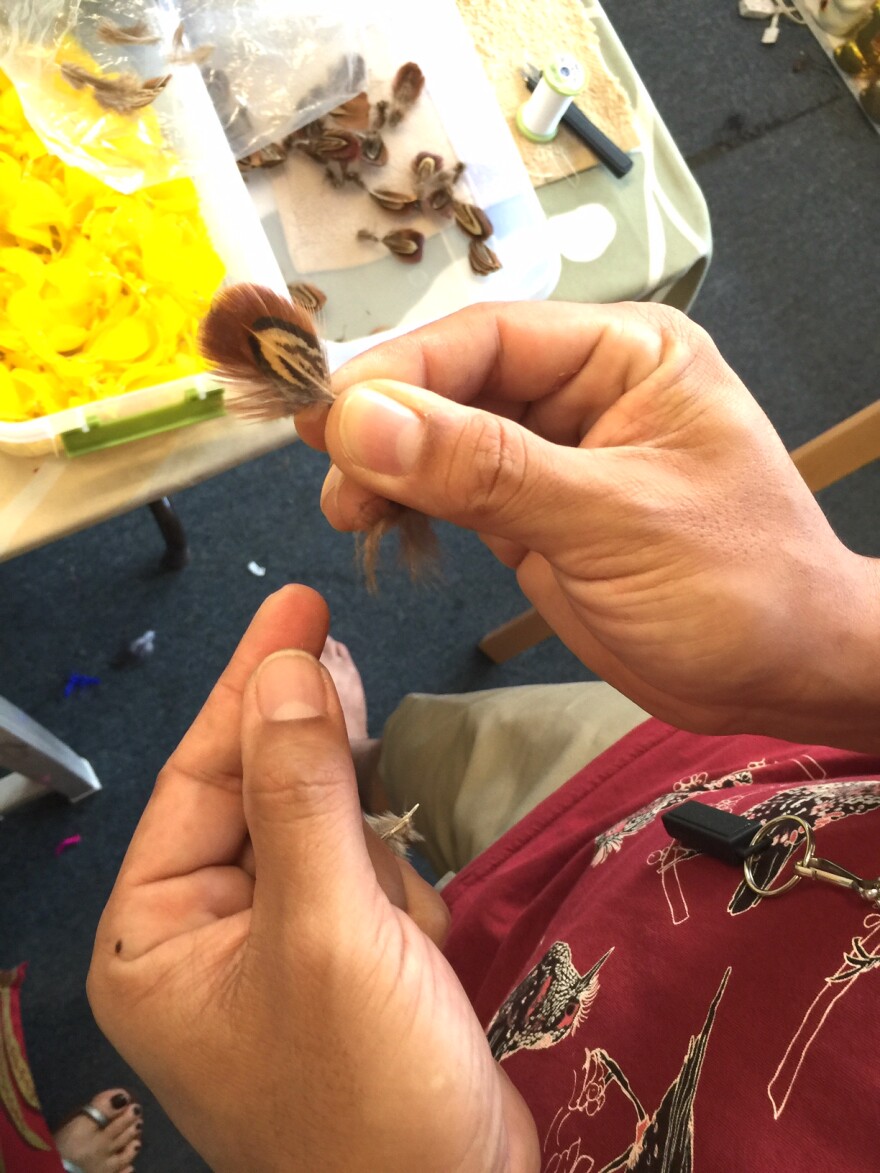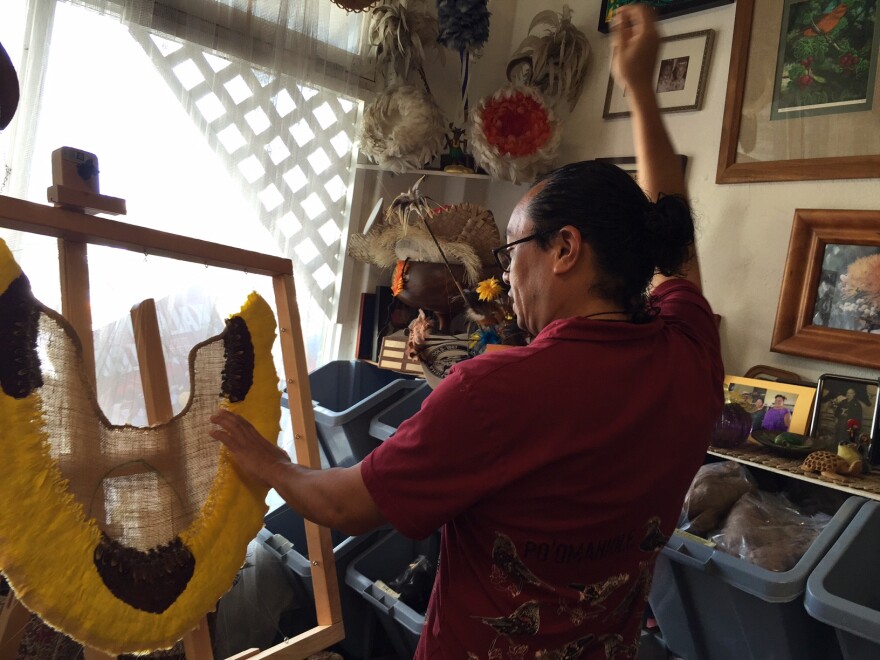The first exhibition of Hawaiian feather work on the U.S. continent created a sensation when it opened at the de Young Museum in San Francisco last year. The exhibition of seventy five stunning capes and cloaks has been held over until April 10ththis year. Meanwhile, the return of Hawai‘i island Chief Kalaniopu’u’s feathered cloak and helmet have reignited interest in feather work here. HPR’s Noe Tanigawa reports on how Hawaiian feather work was made.

We’re here at Na Lima Mili Hulu No‘eau in Kapahulu to meet KawikaLum, the last student of featherwork master Paulette Kahalepuna . He’s making an ‘ahu‘ula, a cape now, but with goose feathers. He says back in the day, collecting feathers was a generational thing.
“In the case with Kamehameha to get that amount of yellow feathers would take generations. But his birth was foretold, right, so our people would think ahead of time to collect these knowing that something or someone was coming that would require that.”
“It’s believed it took about ten generations to gather the feathers that were needed for his (Kamehameha’s) ‘ahu‘ula.” Mele Kahalepuna Chun is following in her mother and grandmother’s footsteps, teaching Hawaiian feather work.
“The feathers themselves, the yellow mamo and ‘i‘iwi, the birds were black. And the yellow feathers came from under the wings. Two feathers under each wing, four feathers per bird. Hard to get. So therefore, if you had more yellow, the stronger your mana. So Kamehameha’s is the only one that’s completely yellow.”

The Kalani?pu‘u cape is thought to have required twenty thousand birds. Chun says gathering feathers was a profession. Nets and traps were used, as well as a sticky sap that could be placed on likely roosts. When a bird landed and got stuck, the bird catcher could pluck the desired feathers, clean the bird’s claws, then release them to grow more feathers. The method of entrapment determined what that birdcatcher was called. Find out more about Hawaiian bird catchers.
Chun shows me four tiny mamo feathers, they’re grey with a mini tuft of yellow at the top. Same with the one bit of red fluff from an ‘apapane. They’re not at all like the big sturdy chicken and goose feathers, dyed solid red and yellow.
Individual feathers are bundled in threes or fives but with the much finer native birds, five feathers were always required. The bundles are then wrapped and tied with string. Then each bundle is sewn securely to a base which today could be yarn or string but was olon? fibers in the old days.
Mele Kahalepuna Chun says, “Creativity is going to happen and people are going to want to do things and do more and do better, but for me personally, I’d like to see us moving backwards to go forward. So being able to produce our own fibers, instead of going and buying thread and buying yarn and ribbon. That’s where I’d like to see feather work going.”
Reminded that her wish for the future would require an environment in which these rare plants and endangered birds could live, Chun responds, “Absolutely.”
According to Lum, “Our whole ahupua‘a system is based off of that mentality of knowing how everything interconnects, so for us to say we’re only going to do feather work would be hewa (wrong) for us to do without using the complete picture of trying to k?kua the environment.”
You can’t just work with feathers?
“If that’s the case, it would be, I’m a feather artist. I’m not a cultural practitioner at that point.”
Asked what he looks for in terms of quality, Kawika Lum replies, “It’s the structure. For me it’s the way

things are constructed. How it’s constructed, what the bundles look like, even as far as lei is concerned, it’s almost always about structure. It goes back to the creator. How close would they want it? How tight of a hand they had. You would have to know the qualities of each feather and try to envision what your lei or ‘ahu‘ula or mahiole would want to look like based on the structure you provide for the feathers.” Chun remarked that men were the feather workers in the old days, and it may come as a surprise, but in her family's experience even today, men have been the most proficient feather workers.
Enjoy the related exhibit at the Bishop Museum, Lele o na Manu, Hawaiian Forest Birds, through July 31st, in the J. M. Long Gallery
Kamehameha’s amazing yellow cape is on the fourth floor of Hawaiian Hall at the Bishop Museum.
Next, we'll head to the uplands of Kaua'i to hear some of the forest birds remaining in Koke'e.





